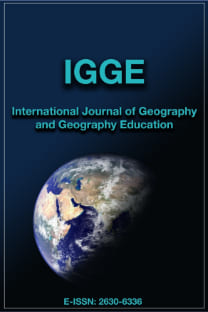COĞRAFYA EĞİTİMİNDE FİZİKİ COĞRAFYA ÖĞRETİMİ İÇİN BİR ROTA ÖNERİSİ: ÇATALCA YARIMADASI BATISI, İSTANBUL
ÖZETSaha çalışması coğrafyanın en önemli öğretim metotlarından biridir ve coğrafya bilimini ve eğitimini saha çalışmasından ayrı düşünmek mümkün değildir. Ayrıca, saha çalışmaları, coğrafya eğitimine çok çeşitli katkılar sağlamaktadır. Bu çalışmanın temel amacı, coğrafya eğitimcilerine çeşitli fiziki coğrafya konularının öğretimi ile ilgili konularda faydalanabilecekleri örnek saha çalışması güzergâhı ve inceleme sahaları ve bunlarla ilgili bilgiler sunmaktır. Böylece, ihtiyaç duyan öğretmen veya akademisyenlerin saha hakkında bilgi sahibi olarak bunları derslerine yansıtmaları hedeflenmektedir. Bu amaçla, İstanbul’un Avrupa yakasını oluşturan Çatalca Yarımadası’nın batısı çalışma alanı olarak belirlenmiş ve saha çalışmaları yapılarak eğitim amaçlı saha çalışmaları için uygun görülen toplam 18 konum iki ayrı güzergâh haline getirilerek raporlaştırılmıştır.Anahtar Kelimeler: Saha çalışması, fiziki coğrafya eğitimi, yapılandırmacılık, yaparak ve yaşayarak öğrenme, İstanbul ABSTRACTField study is one of the most important teaching methods of geography and it is impossible to think field studies isolated from geography education. Also, field studies contribute to geography education in a wide variety of ways. The main purpose of this study is to present example study routes and locations that can be used by physical geography educators. Thus, it is aimed that they can use the presented field study locations in their lessons. For this reason, the European part of Istanbul, named as Çatalca Peninsula, was selected as the study area. A total of two routes and 18 locations were designated as suitable routes and sites for physical geography field studies. The routes and the information about these locations were given in the study.Keywords: Field study, physical geography education, constructivism, learning by doing, Istanbul
Anahtar Kelimeler:
Saha çalışması, fiziki coğrafya eğitimi, yapılandırmacılık, yaparak ve yaşayarak öğrenme, İstanbul
-
Field study is one of the most important teaching methods of geography and it is impossible to think field studies isolated from geography education. Also, field studies contribute to geography education in a wide variety of ways. The main purpose of this study is to present example study routes and locations that can be used by physical geography educators. Thus, it is aimed that they can use the presented field study locations in their lessons. For this reason, the European part of Istanbul, named as Çatalca Peninsula, was selected as the Bu çalışma, Fatih Üniversitesi Bilimsel Araştırma Projeleri (BAP) Fonu tarafından P50011101_G (1882) proje numarası ile desteklenmiştir. study area. A total of two routes and 18 locations were designated as suitable routes and sites for physical geography field studies. The routes and the information about these locations were given in the study.
___
- Armutlu, H., Akçay, M. (2012). Uzaktan Eğitimde Kaynak Yönetimi, Akademik Bilişim Konferansı, 1-3 şubat 2012, Uşak. http://ab.org.tr/ab12/bildiri/5.pdf adresinden Ocak 2013’te edinilmiştir.
- Balcı, A. (2010). The Opinions of The Geography Teacher Candidates About The Place of Field Trips in Geography Teaching, Education, 130 (Summer), 561–572.
- Doğanay, H. (2002). Coğrafya Öğretim Yöntemleri. İstanbul: Aktif Yayınevi.
- Fuller, I., Edmondson, S., France, D., Higgitt, D. ve Ratinen, I. (2006). International Perspectives On The Effectiveness of Geography Fieldwork For Learning, Journal of Geography in Higher Education, 30(1), 89-101.
- Gold, J. R., Jenkins, A., Lee, R., Monk, J., Riley, J., Shepherd, I. D. H. ve Unwin, D. J. (1991). Teaching Geography in Higher Education, Oxford: Blackwell.
- Gök, Y. ve Girgin, M. (2001). Ortaöğretim Coğrafya Programında Deney ve Gezi-Gözlemin Önemi, Doğu Coğrafya Dergisi, 7(6), 61
- Güler, G., Özdemir, E. ve Dikici, R. (2012). İlköğretim Matematik Öğretmenlerinin Sınav Soruları ile SBS Matematik Sorularının Bloom Taksonomosi’ne Göre Karşılaştırmalı Analizi, Erzincan Üniversitesi Eğitim Fakültesi Dergisi, 14(1), 39-57.
- Hupy, J. P. (2011). Teaching Geographic Concepts Through Fieldwork And Competition, Journal of Geography, 110(3), 131-135. İstanbul Çevre Durum Raporu. (2007). Çevre ve Orman İl Müdürlüğü, İstanbul.
- Klein, P. 2003. Active Learning Strategies and Assessment in World Geography Classes, Journal of Geography in Higher Education, 102(4), 146–157.
- Krakowka, A. R. (2012). Field Trips as Valuable Learning Experiences in Geography Courses, Journal of Geography, 111(6), 2362
- Mullens, J. B., Bristow, R. S. ve Cuper, P. (2012). Examining Trends in International Study: A Survey of Faculty-Led Field Courses Within American Departments of Geography, Journal of Geography in Higher Education, 36(2), 223-237.
- Ocak, G. (2008). Öğretim İlke ve Yöntemleri, Ankara: Pegem Akademi, 2
- Panelli, R. ve Welch, R. V. (2005). Teaching Research Through Field Studies: A Cumulative Opportunity For Teaching Methodology to Human Geography Undergraduates, Journal of Geography in Higher Education, 29(2), 255-277.
- Pastore, R. S. (2003). Dale’s Cone of Experience, Principles of Teaching. http://teacherworld.com/potdale.html adresinden Ocak 2013’te edinilmiştir.
- Stoddart, D. ve Adams, E. (2004). Field Work and Unity in Geography. in Unifying Geography: Common Heritage, Shared Future. London, Routledge.
- Şahin, V. ve Özey, R. (2012). İngiltere’de Lisans Düzeyinde Coğrafi Arazi Çalışmaları, Marmara Coğrafya Dergisi, 1-17.
- Tuna, F. (2013). Coğrafya Eğitiminde Saha Çalışmaları, Özey, R., Tuna, F., Bilgen, N. (Ed.), 21. Yüzyılda Değişen Yaklaşımlar ve Yükseköğretimde Coğrafya Eğitimi. Ankara: Pegem Akademi, 219-238.
- Tuna, F. ve Sarıkaya, M.A. (2014). Sarıyer, Beykoz ve Şile’de (İstanbul) Coğrafya Eğitimi İçin Rota Önerileri, Doğu Coğrafya Dergisi, 19(31), 189-206.
- Wall, G.P. ve Speake, J. (2012). European Geography Higher Education Fieldwork and The Skills Agenda, Journal of Geography in Higher Education, 36(3), 421-435.
- Yayın Aralığı: Yılda 3 Sayı
- Başlangıç: 1996
- Yayıncı: Marmara Üniversitesi
Sayıdaki Diğer Makaleler
ENDÜSTRİ ALANI DÖNÜŞÜM PROJESİ SEKAPARK’IN (KOCAELİ-İZMİT) KIYI KULLANIMINA ETKİSİ
TÜRKİYE'DE MÜLKİ İDARİ TAKSİMATA İLİŞKİN YASAL MEVZUATIN DEĞERLENDİRİLMESİ VE SORUNLAR
COĞRAFYA BÖLÜMÜ ÖĞRENCİLERİNİN PORTFOLYO DEĞERLENDİRMEYE İLİŞKİN GÖRÜŞLERİ
FRANSIZ AKÇAAĞACI (Acer monspessulanum subsp. monspessulanum)'NIN TÜRKİYE'DE YENİ BİR YAYILIŞ ALANI
A BRIEF LOOK AT GENERAL AND ENVIRONMENTAL EDUCATION IN NIGERIA
İDARİ VE BÖLGESEL COĞRAFYA PERSPEKTİFİNDEN BELARUS CUMHURİYETİ
